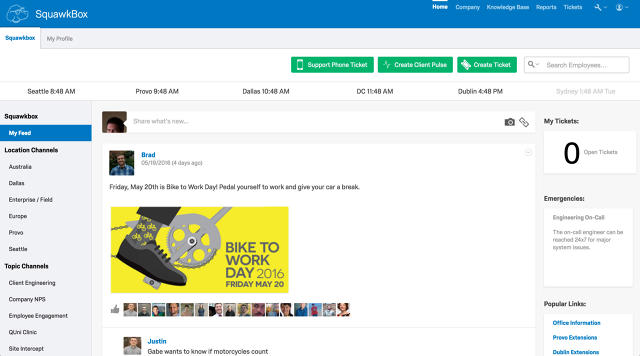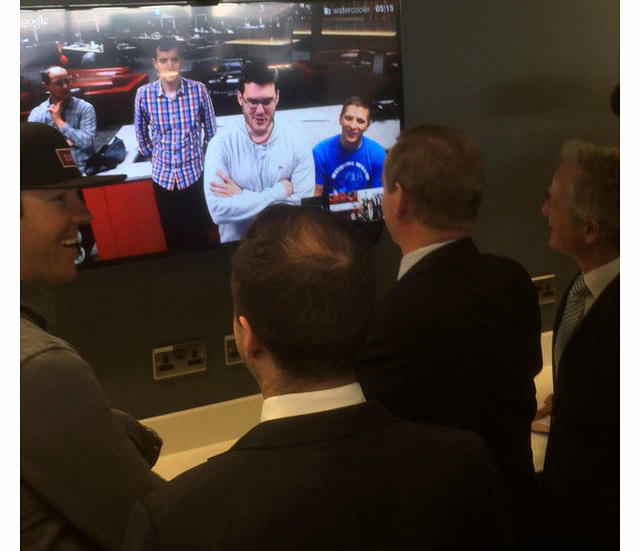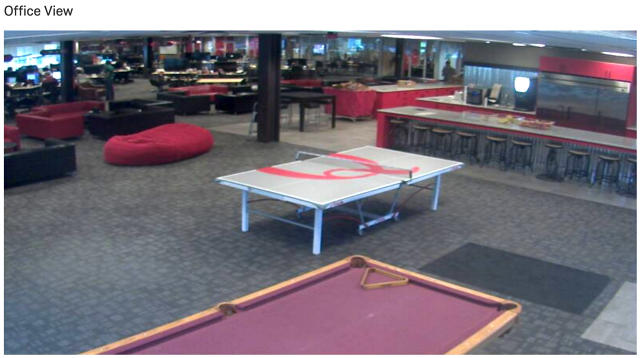The very first thing Ryan Smith says to me is, “it’s probably the furthest thing from the big brother app that you could ever think about.” He knew where my mind was going.
We are talking about an employee communication system he spearheaded, which he described as a Slack-like software system that supposedly offers endless more features to make office life more efficient. Not only does this program, called “Odo,” provide a way for people within an organization to chat with each other, but it also lets employees record their own metrics and request any internal task be done. The feature that caught my eye,though, is that it gives everyone access to birds-eye cameras looking over the office’s entire open floor plan.
Smith is the cofounder and CEO of Qualtrics, an online survey platform for businesses and academic institutions. The Provo, Utah-based company, now with over 1,100 employees, is considered by many to be a quiet tech darling. Qualtrics has raised venture capital twice in the 14 years it’s been around—its last round in 2014 gave the company a valuation that exceeded $1 billion.
Smith, an unassuming yet energetic CEO who routinely wears the startup uniform of hoodies and baseball caps, believes Odo is partially to thank for his company’s success. Or, at least, that Odo helps propel Qualtrics’ thriving culture. He created the software with the assistance of his brother Jared, who helped Google build internal systems. The idea was to code a program that offloaded key management roles, making it possible for people to streamline both communication and other bureaucratic headaches. Smith says Odo does the job of at least 50 employees. Beyond just chatting, the software lets any employee perform tasks that intermediary workers would otherwise do; These include HR duties like on-boarding, managerial paperwork like employee metrics, maintenance requests like reporting a broken heater, and IT communications. While streamlining those tasks certainly makes things more efficient, 50 positions seems a like a bit of an overstatement.
Other than streamlining menial office tasks, Smith also saw an opportunity to embed the entrepreneurial ethos he espouses. In 2012, he cowrote an article for Harvard Business Review about “radical transparency.” “The idea of everyone knowing everything,” the article wrote, “could actually be a major driver of increased organizational performance.” In short, if an organization found a way for all employees to have access to all information, he believes it would provide a competitive edge.
Which is why he reasoned that features like overhead cameras weren’t a means of surveillance, but a way to give everyone ready access to everything. If a meeting is about to happen, people can check the cameras to see if others have occupied the conference room. While some could perceive it as a bit over the top, Smith sees it highlighting how willing he is to share everything with his employees. “We’re so generous with the information we share,” says Smith. “People are blown away that they get access to it.”
How Does Odo Work?
So how does this Slack of the future work? At first glance, Odo is just another boring web-based dashboard. It looks like a more basic, stripped-down version of HipChat or Yammer. There’s a lefthand sidebar, which users navigate to get to specific groups. They are segmented by location (Qualtrics has seven offices around the world, including Dublin, Seattle, London, and Dallas), as well as staff teams. On the top of the dashboards are ways to create tickets, which request specific actions be done. These actions can be anything, including an expense report approval or a maintenance request. On the righthand side is a search bar where you can search for any person at Qualtrics. Employees are able to fill out profiles, with photos and information about who they are.

Again, none of this seems that innovative. The idea of using chat-like software to communicate internally is something that most startups have been doing for a while. And adding the ability to incorporate everyday workflow into the program is a smart way to maximize productivity.
But what makes Odo a little bit different is the type of access it gives people, and what it’s intended to produce from employees. Odo stands for “odometer,” meaning it’s a way to keep track of everything Qualtrics is doing. According to Smith, everyone can see pretty much anything on it, and this is used as a way to encourage performance and collaboration. Marketing employees generally report when they make a big sale. They do so in “Squawkbox,” the main Odo feed. Others then respond to the big business news with comments and emojis. On that same feed, employees from all departments can congratulate the event. Qualtrics employees also use Squawkbox to send birthday greetings or congratulations on an upcoming child. The feed melds together this information so that everyone has the ability to share whatever they want. As anyone who’s used the kinds of products, this channel is very similar to the main feeds used in internal Slack channels.
Squawkbox, however, isn’t the only open channel. Employees can check on their colleagues to see what they’re up to and what tasks they are doing. Very few things are private in Odo, at least when it comes to day-to-day tasks.
Beyond Squawkbox, employees are also able to check out the dozens of cameras in most of the offices. These cameras are mounted in the ceilings of Qualtrics’ open offices, and provide a panoramic view. Smith is quick to say that this ability is not meant to snoop on employees. Of the camera shots that I saw, they looked across many desk rows of people working. You can’t see what people are working on, but you can notice if someone isn’t by their work station. Smith says this is another avenue for everyone to see and know all happenings within the Qualtrics walls. If I’m looking to meet with a coworker I can check the camera feed to see if they’re by their computer or in a common area. The idea is that it gives employees a greater sense of community, since it includes many of the offices. For instance, the Dublin office has similar cameras set up, so employees can even see (kind of) the events there.
Bolstering this are the water coolers. On every floor in the Provo office is a drink station with a screen and camera mounted atop it. This screen connects with the other offices around the world, making it possible for trans-Atlantic water cooler conversation. The system is voice-activated, so if someone is talking to the screen in Dublin, people in Provo will see who’s on the line. Smith loves to tell the story about the time the Prime Minister of Ireland came to the Dublin offices and was able to talk with the team back in the U.S. I will admit that it’s kind of thrilling to look at a computer screen and see a group of people in another country waving back at you.

According to Smith, all of this is to make every employee feel comfortable and included. Even though people are working at a big company with many offices, he says, “it’s very difficult to feel like you’re not a part of it.” Odo integrations like these are ways to connect the disparate Qualtrics links.
Related: The Office Is Watching You
Overhead cameras aren’t the only way employees are given the “radical” access that Smith is so fond of. Odo is also a way to keep track of internal metrics for all to see. Every week everyone is expected to fill out something called “Snippets,” which are weekly goals. It’s a way for managers to know what their employees are doing, for workers to plan out the week ahead of them, and for everyone to see what everyone else is doing (if they care to). As with everything else on the Odo platform, it’s open for everyone to see. At the end of the week you check off what you accomplished, thus you can see what everyone else in the company did—Smith included.
The CEO sees this is a smart way to grade performance. More importantly, he sees these features as motivators. “It allows people to emulate the competent individuals,” he says. If someone is doing great, their performance will shine on the Odo platform. And then, Smith hopes others will see this and act accordingly.
It’s A Question Of Culture
At the heart of these features is the gnarly issue of company culture. Smith believes Qualtrics’ quirky openness makes it stand apart from other organizations. This ability to see and know everything is baked into the company’s DNA; it’s something he proclaims proudly.
The sharing is meant to encourage others to get a glimpse of the top performers; it encourages a sort of competitiveness mixed with community. If someone using Odo thinks it’s too open, or that comparing performance metrics to every other employee doesn’t jive with their work ethic, they should conclude “maybe Qualtrics isn’t for me,” says Smith. “That’s a great situation for us,” he adds.
Odo In Action
After talking with Smith for a while about the program, I wanted to see it in action. So while a Qualtrics employee walked around with a laptop I Skype-watched the open office.
In reality, Odo is like any other internal communication platform. Employees chat with each other, post news, share other work-related info. I use Slack in a very similar manner. And I’ll admit, some of the features were cool. As I talked about earlier, I got to see one of the water coolers and waved at people in Dublin, who were sitting in an open lounge-like area.

But perhaps that’s the insidiousness of the radical transparency. The platform looks like any other piece of mundane work software you operate, and its abilities become normalized. I asked an employee how she felt about the cameras. “It kind of freaked me out at first,” she said, “there was one right above my desk and I was like ‘holy cow.’” But she says that she quickly got used to it. “I don’t think anyone really looks at what people are doing. It’s mostly just to check on the kitchen.”
For Smith, the merits of sharing this information outweigh the concerns. At once it streamlines all of his company’s internal info-share—he says it “cut down on 50% of the email”—and also perfectly illustrates the type of atmosphere he’s trying to cultivate. Qualtrics is made up of more than three-quarters millennials, and Smith thinks Odo-like productivity programs speak to them. “The default is to share, especially among that generation.” It’s true an employee described Odo to me as an “internal Facebook.”
He sees this thesis transcending beyond Qualtrics’ “radically transparent” walls. When first described to me, Odo was a “Slack killer.” When pressed on that, Smith doubled down. He maintains that any company would see dramatic performance improvement if they installed a similar system. One day he thinks he’ll start selling Odo to other organizations. He even believes it could become a major Qualtrics offering.
Of course, other startups would have to get on board with sharing absolutely everything, and that likely won’t work with many organizations. Smith knows this too. While he considers Odo to be one of the best growth hacks his company has, he adds, “I don’t think all companies are ready for this.”
Related video: 9 Ways You’re Effectively Destroying Your Startup
Fast Company , Read Full Story
(61)